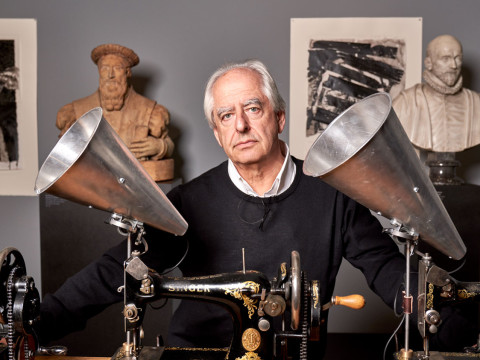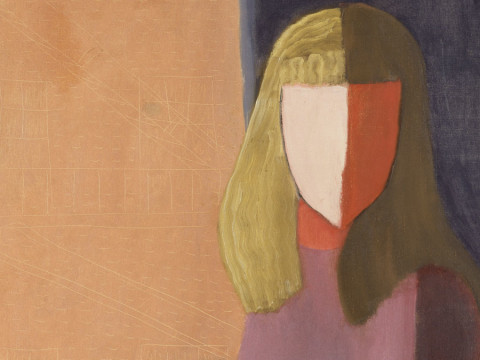
Anselm Kiefer: a beginner's guide
By Tom Jeffreys
Published on 24 September 2014
This week the RA welcomes the works of German artist Anselm Kiefer: from intimate watercolours and artist’s books, to vast paintings, complex sculpture, and installations on a monumental scale.
Kiefer is one of the most important artists of the last 50 years. But this year’s exhibition is his first major retrospective in the UK. For those new to his work, here are six key facts to get you started on a journey of discovery.
Born: Germany, 1945
Anselm Kiefer was born in Donaueschingen, a small town in Germany’s Black Forest on 8th March 1945, shortly before the end of the Second World War. He grew up in a country divided and struggling with its sense of past and future. While many German artists of his era shied away from their country’s recent history, Kiefer confronted it directly. His first major work – and arguably still his most controversial – was 1969’s 'Occupations': a series of photographs depicting the artist in his father’s military uniform performing the Nazi salute.

First patron: Georg Baselitz
Kiefer emerged as part of an influential generation of post-war German artists that included Sigmar Polke and Gerhard Richter. He was supported in the early years of his career by two more of the country’s leading artists: Joseph Beuys, who acted at times as a mentor for the young Kiefer, and Georg Baselitz, who bought many of Kiefer’s paintings in 1974. It was alongside Baselitz (whose collection of chiaroscuro woodcuts was on show here at the RA for Renaissance Impressions) that Kiefer represented Germany at the 1980 Venice Biennale, and again examined the iconography of Nazism head-on.

Key theme I: memory
Although informed by history, Kiefer is more an artist of memory – private and public, personal and political. His paintings are packed with references to myth and poetry. Art critic Robert Hughes described Kiefer’s work as centring on two questions: “What can I remember?” and “What should I remember?” Kathleen Soriano, who has curated the RA’s exhibition, says Kiefer’s work is “as much about the present as it is about the past”. This is exemplified in paintings such as Interior (1981), which depicts a room in the New Reich Chancellery, designed by Hitler’s favourite architect, Albert Speer. The building had been destroyed immediately after the war, but Kiefer chooses to depict the moment of ruination itself. The result, writes Martin Gayford in RA Magazine, is a painting of “spectral, sinister magnificence”.

Key theme II: micro/macro
In the last 20 years or so, Kiefer's has increasingly sought to draw out links between the individual and the universal. Since the mid-'90s, he has explored the importance of the constellations as part of the cyclical nature of time and life. Other works from this period, such as The Orders of the Night (1996), show huge crops of sunflowers looming over the body of the artist. At the same time, Kiefer has been producing works on a much smaller scale: the RA's exhibition includes a number of artist's books, which demonstrate a more intimate side to the artist's practice.

Key material: lead
Incorporating materials such as concrete, straw, ash and shellac, Kiefer's works often decay with age, and the artist embraces this loss of control. Embodying this mutability is lead, which alchemists once believed could be turned into gold. Books – often with wings – have been a repeated motif since the late 1960s and represent, for Kiefer, important repositories of learning, religion, culture. Many of these book sculptures are made of lead, which Kiefer first used to mend his plumbing in the 1970s. He has subsequently described it as “the only material heavy enough to carry the weight of human history”.

Greatest work: his studio?
Kiefer’s work is not limited to painting or photography, but includes sculpture and installation on a vast scale. In 1992, Kiefer moved his studio from Germany to Barjac in southern France. Not only did the landscape – in the form of sunflowers – seep into his work, but his work also had a major impact upon the landscape. Kiefer transformed 35 hectares of derelict industrial land into a gesamtkunstwerk – a total work of art – that includes archives, installations, storerooms, underground chambers, and huge concrete towers (two of which were here in the RA courtyard back in 2007).
Kiefer has since relocated to the outskirts of Paris (it took 110 lorries to do the move) while Barjac remains. Tim Marlow, the RA’s Director of Artistic Programmes, likened it to “an ancient civilisation that has declined and been rediscovered.” But Barjac is more than just a slowly decaying memorial: Kiefer has started to invite other artists to visit the site and create new work themselves. In Kiefer’s work as in life, the cycle of ruin and new growth continues.
Anselm Kiefer is in the Main Galleries at the RA from 27 September – 14 December 2014.
Tom Jeffreys (@tomjeffreys) is a writer, editor and curator.
Related articles

A beginner's guide to William Kentridge
19 July 2022

A beginner's guide to Milton Avery
12 July 2022

13 things to know about Francis Bacon
14 February 2022

Light Lines Tour with Hélène Binet
23 November 2021

A beginner's guide to Michael Armitage
21 May 2021
